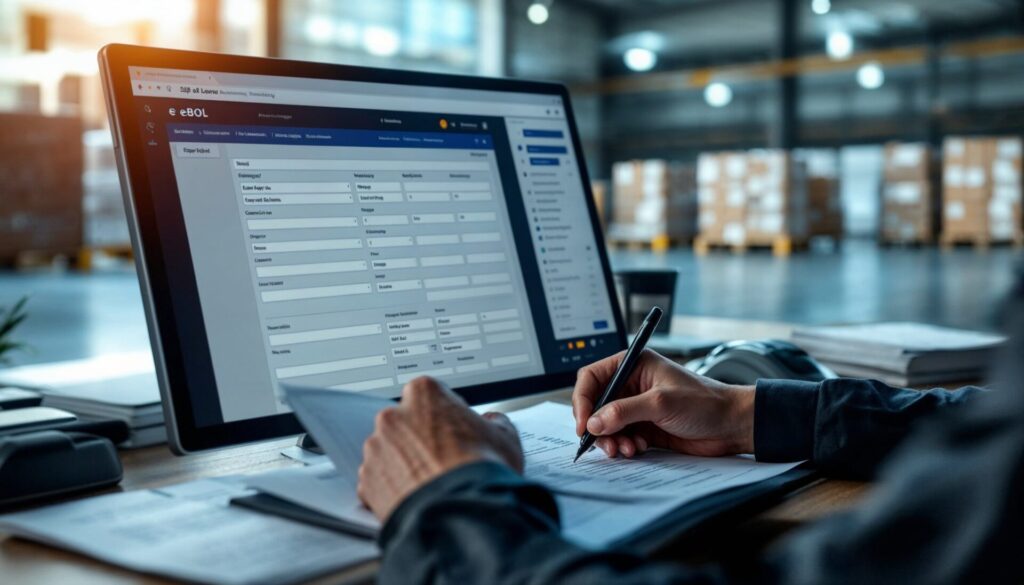
How to Use Bill of Lading Forms Efficiently
When it comes to shipping and logistics, a well-executed Bill of Lading (BOL) stands at the center of every transaction. It not only identifies the freight, shipper, and consignee but also details terms of carriage, liability limits, and payment responsibilities. With so much riding on this document—potential claims, regulatory compliance, on-time delivery—shippers must handle it with meticulous care.
This article breaks down the best ways to use Bill of Lading forms efficiently, helping you minimize clerical errors, avoid delays, and maintain solid carrier relationships. We’ll explore everything from gathering shipment data to leveraging electronic BOLs (eBOL) for a faster, paperless workflow. By integrating these best practices, you can streamline your day-to-day logistics operations and reduce the risk of costly disputes.
Introduction
Importance of a Proper Bill of Lading (BOL)
A BOL functions as a legal contract between the shipper and the carrier, confirming what’s being transported, where it’s headed, and who’s responsible for freight charges. If something goes wrong (e.g., lost or damaged goods), the BOL is the primary reference for settling claims. Inaccuracies—like the wrong consignee address or missing freight class—can lead to rework, additional fees, or delayed shipments.
Common Mistakes and Their Consequences
- Incorrect Weight: Triggers carrier reweigh fees or reclassification.
- Missing Shipper/Consignee Info: Results in misrouting, storage fees, or returned shipments.
- Unclear Terms: Payment and liability confusion, more likely disputes.
Preparing your BOL carefully at the outset prevents such pitfalls and cements a smoother supply chain.
Understanding the Basics of the Bill of Lading
Definition and Main Purposes
A Bill of Lading serves multiple functions:
- Evidence of Contract: Outlining pickup, transit, and delivery terms.
- Receipt of Goods: Carrier’s acknowledgment of receiving freight in good order.
- Document of Title: In certain forms (like Order BOL), it can control the transfer of ownership.
Role in Legal and Financial Transactions
Because it’s a binding contract, the BOL impacts insurance claims, regulatory checks, and even bank loans if goods serve as collateral. An accurate, valid BOL underpins many legal or financial decisions within the shipping process.
Types of Bill of Lading Forms
Straight vs. Order BOL
- Straight BOL: Names a specific consignee and is non-negotiable. Typically used for direct shipments where ownership transfer is straightforward.
- Order BOL: Allows the shipper to endorse or “order” the goods to another party, making it negotiable. Common when selling goods in transit.
Electronic BOL (eBOL) vs. Paper BOL
Some carriers and 3PLs facilitate eBOL systems, enabling digital forms to accelerate booking and reduce errors. E-signatures replace physical signatures, and data flows seamlessly into TMS or ERP systems for better visibility.

Gathering Accurate Shipment Data
Weight, Dimensions, and Commodity Description
Collect precise measurements:
- Weight: Include packaging, pallets, or crates.
- Dimensions: For each pallet or box, as carriers often use volumetric calculations.
- Commodity Description: Use standard names, not internal codes, especially for cross-border or regulated goods.
Packaging and Handling Details
Carriers must know if your freight is stackable or if it requires special handling (e.g., “Fragile,” “Do Not Stack”). Noting these on the BOL influences loading decisions and may prevent damage or misrouting.
Key Elements of a Bill of Lading
Shipper, Consignee, and Third-Party Billing Info
Fill out:
- Shipper (Origin): Company name, address, contact person, phone number.
- Consignee (Destination): Where to deliver. Could be a customer, a distribution center, or a third party.
- Third-Party Billing: If someone else (e.g., 3PL, parent company) pays freight charges.
Freight Class, NMFC Code, and Special Services
Freight class and NMFC codes—particularly relevant in LTL—determine rates and handling methods. Additional services—liftgate, inside delivery, limited access—should be clearly specified to avoid last-minute fees or delays.
Terms and Conditions (Incoterms, Liability Limits)
Define who owns the cargo during transit, who’s paying insurance, and the limit of carrier liability. If shipping internationally, reference Incoterms (e.g., EXW, FOB) for precise responsibilities between buyer and seller.
Steps to Fill Out a BOL Form Efficiently
Ensuring Correct Names and Contact Information
Small typos—like a missing suite number or reversed street name—can cause misdeliveries or returned shipments. Double-check addresses and phone numbers. If your consignee moves or changes contact details, update them in your system so the BOL stays current.
Accurately Listing Freight Class and Weight
Failure to assign the proper NMFC code or the correct class triggers reweigh or reclassification, delaying transit. Weigh your shipment with a calibrated scale, confirm the packaging dimension, and consult the NMFC directory or a broker for classification guidance.
Double-Checking Payment Instructions
Indicate whether the shipping charges are prepaid, collect, or third-party. If the BOL doesn’t align with your intended billing arrangement, carriers may hold your freight until payment details are clarified.
Using Technology for BOL Management
Digital Portals and TMS Integration
Modern Transportation Management Systems (TMS) and carrier portals can auto-populate BOL fields based on existing data, reducing manual entry errors. Digital solutions also store electronic copies, making retrieval faster for audits or disputes.
Printing and Storing eBOL Copies
Even if you use eBOL, carriers may still require a paper printout at pickup. Keep at least one paper copy for the driver and another for your records. File eBOL forms electronically in an organized folder structure or a TMS database for compliance or future reference.

Avoiding Delays and Errors
Consistency Across All Shipping Documents
Ensure the BOL, commercial invoice, and packing list convey uniform details—like exact item counts, weights, and addresses. Mismatched documents invite confusion, potential holds at cross-docks, or even customs delays for international shipments.
Proper Labeling to Match the BOL
Each pallet or box should display the same references—PO number, consignee name, or special instructions—as indicated on the BOL. This alignment helps carriers cross-check details at each transfer point, reducing misrouting risks.
Special Considerations for Cross-Border Shipments
Commercial Invoices, Customs Documents, and BOL Alignment
For international freight, the BOL often works in tandem with commercial invoices, certificates of origin, or export declarations. If these forms don’t match, customs authorities may detain your cargo. Double-verify product descriptions, HS codes, declared values, and shipper/consignee addresses.
Avoiding Country-Specific Compliance Pitfalls
Some nations require extra disclaimers on the BOL—like “Freight charges must be prepaid” or “No partial deliveries.” Check local regulations or partner with a customs broker to incorporate any mandated language, preventing inbound clearance hiccups.
Resolving Disputes and Claims
BOL as Proof of Shipment and Condition
If goods arrive damaged or short, carriers or insurers look to the BOL for clues on the initial condition. A driver’s signature acknowledges receiving freight “in good order.” Document exceptions clearly if anything was off at pickup or if damage was visible at loading.
Steps for Filing Damage Claims or Shortages
- Note Damages on the delivery receipt upon arrival.
- Photograph the compromised freight and packaging.
- Gather Documentation: BOL, cargo insurance policy, and proof of product value.
- Submit a formal claim to the carrier or broker promptly—often within a set timeframe (e.g., 5–15 days).
Best Practices for Recordkeeping and Audits
Retention Period and Organizational Tips
Regulatory bodies like the FMCSA (Federal Motor Carrier Safety Administration) may require carriers (and sometimes shippers) to keep BOL records for a specific period, commonly 3–5 years. Digitizing these forms speeds retrieval if you need them for tax audits or legal inquiries.
Quick Retrieval for Compliance Checks
When carriers or legal teams request older BOLs, an organized digital archive fosters swift compliance. Tag each BOL with a reference number or date, plus relevant metadata like shipper/consignee names or NMFC codes.
Conclusion
The Bill of Lading is more than just a form—it’s a cornerstone of every shipping transaction. By taking the time to accurately fill out each field, align packaging labels with BOL data, and store these documents properly, you set your freight up for smooth transit and minimal confusion. Technology, from eBOL solutions to TMS integrations, streamlines the process further, cutting down on manual errors and speeding up your documentation cycle.
In an industry where simple mistakes can lead to significant costs—like missed deliveries, reclassification fees, or claims disputes—the BOL stands out as a critical control point. Embrace best practices in BOL management to keep your shipments on track, protect yourself legally, and maintain strong carrier relationships.
How useful was this post?
Click on a star to rate it!
Average rating 5 / 5. Vote count: 1
No votes so far! Be the first to rate this post.



